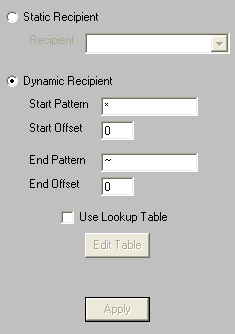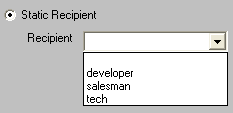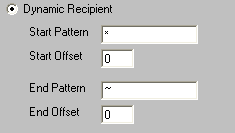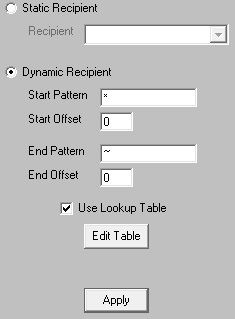\ |
IMPORTANT This character, unless specified otherwise in the Symbols section, represents the character that tells PageGate that the three characters following it represent an ascii decimal value/ascii code. For instance, if you want to tell PageGate to look for a carriage return, you would use a backslash and the three character ascii decimal value representing a carriage return. Written out, that would be \013
For a full list of ascii codes, visit http://www.asciitable.com/ |
This section is where you tell GetASCII what represents who the messages should go to.

There are two possible configurations you can use:
•Static Recipient

Selecting this option tells the GetASCII module that all messages processed from the ascii file should go to the specified recipient or group.
•Dynamic Recipient

Selecting this option tells the GetASCII module to look for specific patterns that denote where the recipient information is located in within the record.
•Start Pattern
This value determines the first character in the recipient value.
For example, let's say this is the record identified and let's also say that who the message needs to go to is contained in the SubscriberName= field:
SubscriberName=AgencyToDispatch
[MESSAGE]
Line1=Type of call
Line2=Address information.
Line3=Cross-street information.
Line4=Dispatcher notes.
You would want to use SubscriberName= as the Start Pattern of the recipient information.
Note: Start patterns are included in the recipient processed unless you specify the otherwise with the Start Offset. See below.
•Start Offset
This value determines how many characters before or after the identified start pattern to accept as the recipient value. This field can be set to positive or negative values.
For instance, a value of 5 means that GetSerial will begin looking for the recipient value 5 characters after the first character in the Start Pattern. A value of -5 means that GetSerial will begin looking for the recipient value 5 characters before the first character the Start Pattern.
To use our earlier example, we would want a Start Offset of 15 because there are 15 characters in SubsciberName= and we don't want that text included as part of the recipient or group designation.
•End Pattern
This value determines the last character in the recipient value.
Using our earlier example, we've already specified that the recipient value starts with SubscriberName= but what does it end with?
SubscriberName=AgencyToDispatch
[MESSAGE]
Line1=Type of call
Line2=Address information.
Line3=Cross-street information.
Line4=Dispatcher notes.
This is where things are ultimately up to your preferences. The first thing that technically follows the recipient name in our example is a carriage return followed by a line feed (represented visually as a line break but as two ascii codes/characters in the text being processed), not the text [MESSAGE]. However, you could tell PageGate to use either \013 (the ascii value representing a carriage return) or [MESSAGE] as the End Pattern as both clearly identify the end of recipient information. However, you would use a different End Offset for each. See below.
•End Offset
This value determines how many characters before or after the identified End Pattern to stop character recognition. The discovered value is not included in the overall statement. This field can be set to positive or negative values.
For instance, a value of 5 means GetASCII will stop looking for the recipient value 5 characters after the first character in the End Pattern. Using our earlier example, if your End Pattern is [MESSAGE] and you specify a value of 5, the data for the recipient will end with [MESS and you don't want that. If your End Pattern is \013 and you specify a value of 5, the data for the recipient will end with <CR><LF>[ME and you don't want that.
On the other side of the coin, a value of -5 means GetASCII will stop looking for the recipient value 5 characters before the first character the End Pattern. Using our earlier example, if your end pattern is either \013 or [MESSAGE] and you specify a value of -5, the first five characters in the recipient line will be lost and you don't want that.
To use our earlier example, if we have \013 specified as the End Pattern, you would use a End Offset of -1 thereby telling GetASCII not to include the carriage return as pert of the recipient or group designation. If we have [MESSAGE] specified as the End Pattern, we would use an End Offset of 0.
The lookup table enables PageGate to perform basic search and replace commands. This allows you to interchange or translate values as needed. To enable this feature, check Use Lookup Table and click Edit Table.
